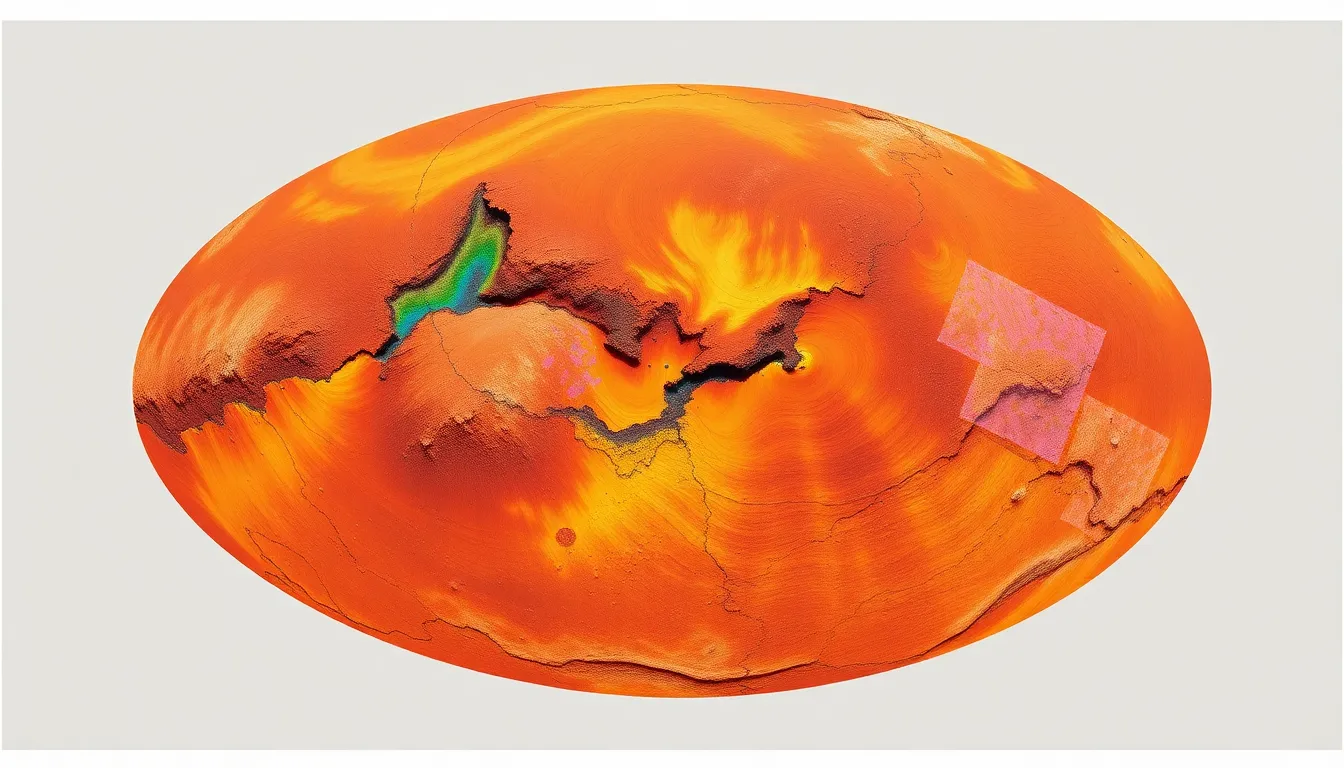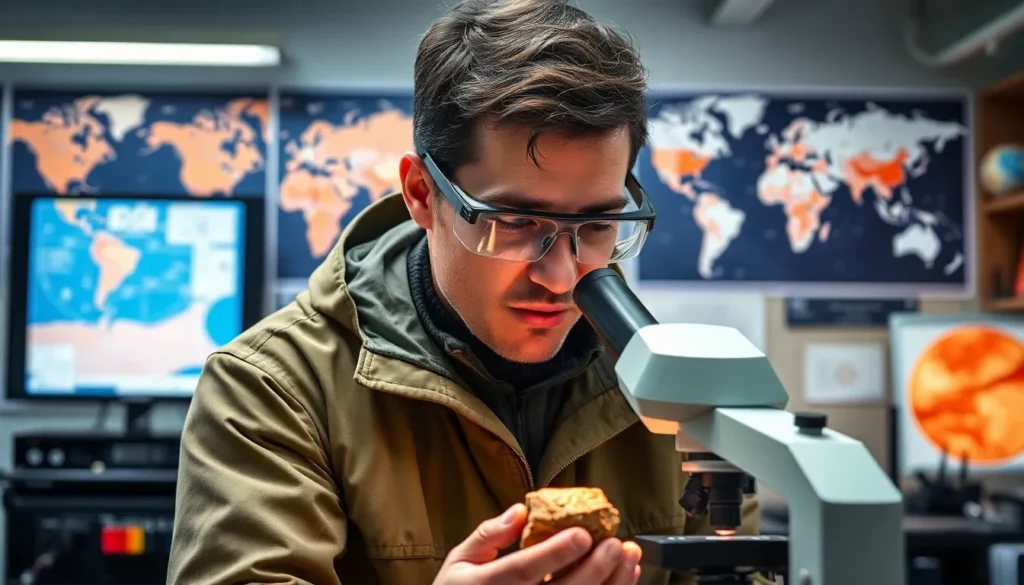When it comes to exploring the cosmos, most folks think of rocket ships and astronauts. But what if we told you there’s a whole field dedicated to studying the rocks and landscapes of other planets? Enter astrogeology—the cosmic cousin of geology that’s all about understanding our celestial neighbors. From the dusty plains of Mars to the icy moons of Jupiter, astrogeologists are the fearless rock hounds of space.
Table of Contents
ToggleWhat Is Astrogeology?
Astrogeology examines the geology of celestial bodies. This field analyzes the composition and structure of rocks and landscapes beyond Earth.
Definition and Scope
Astrogeology studies the geological characteristics of planets, moons, asteroids, and comets. It involves analyzing surface features, mineral compositions, and geological processes. Scientists apply techniques like remote sensing and geochemical analysis. Data from space missions to Mars, Venus, and icy moons provides critical insights. This discipline helps in understanding planetary formation and evolution. Astrogeologists also contribute to identifying potential resources for future exploration.
Importance in Planetary Science
Astrogeology plays a crucial role in planetary science. Understanding the geological features of other worlds aids in answering fundamental questions about their histories. Insights into past volcanic activity and impacts inform models of planetary development. Knowledge from astrogeology helps determine whether conditions for life existed elsewhere. Through analyzing sedimentary deposits, scientists can identify past water presence. This information shapes future exploration efforts and enhances the search for extraterrestrial life.
Major Domains of Astrogeology

Astrogeology encompasses several key domains that enhance understanding of celestial environments. Two significant areas are planetary surface processes and geological mapping of celestial bodies.
Planetary Surface Processes
Planetary surfaces undergo various processes that shape their features. Erosion, volcanism, and tectonics play crucial roles in defining characteristics of these surfaces. For instance, Mars exhibits significant volcanic activity evidenced by shield volcanoes like Olympus Mons. Erosion on the Moon results from micrometeorite impacts creating regolith. Additionally, tectonic movements on Europa contribute to its unique ice features, providing insights into its subsurface ocean. Understanding these processes helps scientists interpret planetary histories and assess potential habitability.
Geological Mapping of Celestial Bodies
Geological mapping serves as a fundamental tool in astrogeology. This process involves analyzing surface features and compositions to create detailed maps of celestial bodies. Space missions, such as those by NASA and ESA, transmit high-resolution images, aiding in discerning distinct geological units. Mars Reconnaissance Orbiter captures detailed terrain, while Lunar Reconnaissance Orbiter maps the Moon’s surface. Furthermore, satellite data assists in identifying mineral compositions, guiding future exploration efforts. Such mapping informs models of planetary evolution and assists in locating resources critical for future missions.
Techniques Used in Astrogeology
Astrogeology employs various innovative techniques to explore celestial bodies and their geological features. This approach enhances understanding of planetary processes and histories.
Remote Sensing
Remote sensing plays a crucial role in astrogeology. Instruments aboard spacecraft capture high-resolution images of planetary surfaces. Satellites provide invaluable data on landscape features, mineral compositions, and topography. For example, Mars Reconnaissance Orbiter offers detailed imagery that reveals ancient riverbeds and volcanic structures on Mars. This technique enables scientists to analyze surface changes over time without direct contact. As a result, researchers can identify geological processes like erosion and sedimentation from a distance.
Sample Return Missions
Sample return missions significantly advance astrogeology. These missions retrieve rock and soil samples from celestial bodies for on-Earth analysis. For instance, NASA’s Mars 2020 Perseverance rover collected rock samples showcasing Martian geology. This direct examination provides insights into the composition and history of the samples, supporting theories about planetary development. Other missions, like Japan’s Hayabusa2, returned samples from asteroids, revealing organic materials essential for understanding life’s building blocks. These efforts enhance knowledge about planetary evolution and inform future exploration.
Recent Discoveries in Astrogeology
Significant strides continue in astrogeology, driven by advanced missions and innovative techniques. Recent findings provide deeper insights into celestial bodies.
Mars Exploration
Mars exploration reveals a complex history shaped by volcanic activity and water flows. The Mars 2020 Perseverance rover unveiled ancient river delta formations, indicating previous water presence. Analysis of Martian soil samples illuminates the planet’s potential for past life. Moreover, the data collected by the Mars Reconnaissance Orbiter offers evidence of extensive groundwater and mineral deposits. Features such as the Jezero Crater showcase outstanding geological diversity, advancing understanding of Martian environmental conditions.
Lunar Studies
Lunar studies have advanced through missions like NASA’s Artemis program. Recent analyses of lunar regolith suggest significant presence of water ice in permanently shadowed craters. Discoveries from the Lunar Reconnaissance Orbiter indicate the Moon’s surface is replete with a variety of volcanic landforms. Findings from sample returns, including those from the Apollo missions, reveal the Moon’s geological evolution since its formation. The study of impact craters further provides insights into the Moon’s history and cosmic events that shaped it.
Challenges and Future Directions
Astrogeology faces several challenges that influence research and exploration. Limited access to celestial bodies restricts comprehensive geological studies. High costs of missions often result in prioritizing specific objectives, leaving some geological questions unanswered.
Technological advancements continue to play a crucial role in addressing these challenges. Improved remote sensing techniques yield better data quality from distant environments. An increase in miniaturized instruments enhances the potential for more frequent and cost-effective missions.
Future directions in the field focus on integrating data from diverse sources. Collaboration between space agencies, researchers, and private companies fosters a wealth of knowledge on planetary bodies. This synergy leads to innovative mission designs and shared findings that enrich the research landscape.
Utilizing artificial intelligence for data analysis presents another promising area. AI can sift through vast quantities of geological data, identifying patterns and making predictions more efficiently. This technology accelerates the pace of discovery, contributing to a deeper understanding of planetary processes.
Expanding the search for extraterrestrial life remains a primary objective. Discovering signs of past conditions that supported life opens exciting avenues for exploration. Missions targeting ocean worlds, like Europa and Enceladus, could unveil crucial information about habitability beyond Earth.
Assessing the geological diversity of various celestial bodies shapes future exploration priorities. Ongoing studies emphasize the importance of places like Mars’ Jezero Crater and the Moon’s permanently shadowed regions. Findings from these locations spark interest in their potential resources, guiding mission plans and research developments.
Astrogeology stands at the forefront of understanding the complex geological processes that shape celestial bodies. Its insights not only enhance knowledge of planetary evolution but also guide future exploration missions. As technology advances and collaboration among various entities increases, the field is poised for significant breakthroughs.
The ongoing search for extraterrestrial life and the analysis of diverse geological environments will continue to fuel curiosity and innovation. With each discovery, astrogeologists unravel the mysteries of the universe, paving the way for a deeper understanding of our cosmic neighbors. The future of astrogeology promises exciting possibilities that extend humanity’s reach beyond Earth.




